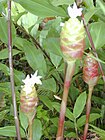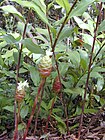Note: This is a project under development. The articles on this wiki are just being initiated and broadly incomplete. You can Help creating new pages.
Difference between revisions of "Zingiber zerumbet"
(Created page with "{{stub}} ==Uses== {{Uses|}}, {{Uses|}}, {{Uses|}}, {{Uses|}}, {{Uses|}}, {{Uses|}}, {{Uses|}}, {{Uses|}}, {{Uses|}}, {{Uses|}}, {{Uses|}}.<ref name="Uses"/> ==Parts Used== {{...") |
|||
| Line 1: | Line 1: | ||
| − | + | [[File:'Awapuhi 'ula'ula, "Red Ginger".jpg|thumb|right]] | |
| + | Zingiber zerumbet is a herbaceous, perennial plant producing clumps of leaves from a large rhizome. The leaves form a pseudostem from 60 - 200cm tall. A popular and widely cultivated plant in southeast Asia where it is used as a medicinal plant and spice. The roots are sold in local markets in Java. The plant also produces very ornamental flowering heads and is widely grown in gardens. | ||
==Uses== | ==Uses== | ||
| − | {{Uses|}}, {{Uses|}}, {{Uses|}}, {{Uses|}}, {{Uses| | + | {{Uses|Asthma}}, {{Uses|Coughs}}, {{Uses|Worms}}, {{Uses|Leprosy}}, {{Uses|Rheumatic joints}}.<ref name="Uses"/> |
==Parts Used== | ==Parts Used== | ||
| − | {{Parts Used|}}, {{Parts Used| | + | {{Parts Used|Young rhizomes}}, {{Parts Used|Young leaves}}, {{Parts Used|Young flower spikes}}. |
==Chemical Composition== | ==Chemical Composition== | ||
| − | <ref name="chemical composition"/> | + | The most abundant components were monoterpenes (76.1%): camphene (15) (16.3%), sabinene (16) (14.6%), citral (17) (26.1%), zingiberene (18) (7.2%) and lavandulyl acetate etc.<ref name="chemical composition"/> |
==Common names== | ==Common names== | ||
| Line 16: | Line 17: | ||
===Dravya=== | ===Dravya=== | ||
===Rasa=== | ===Rasa=== | ||
| − | |||
===Guna=== | ===Guna=== | ||
| Line 29: | Line 29: | ||
==Habit== | ==Habit== | ||
| − | {{Habit|}} | + | {{Habit|Perennial}} |
==Identification== | ==Identification== | ||
| Line 48: | Line 48: | ||
==Mode of Propagation== | ==Mode of Propagation== | ||
| − | {{Propagation|}} | + | {{Propagation|Seeds}} |
==How to plant/cultivate== | ==How to plant/cultivate== | ||
| − | <ref name="How to plant/cultivate"/> | + | Prefers a position in humid woodland shade. Prefers a fertile, humus-rich soil.<ref name="How to plant/cultivate"/> |
==Commonly seen growing in areas== | ==Commonly seen growing in areas== | ||
| − | {{Commonly seen| | + | {{Commonly seen|Moist places in forests}}. |
==Photo Gallery== | ==Photo Gallery== | ||
<gallery class="left" caption="" widths="140px" heights="140px"> | <gallery class="left" caption="" widths="140px" heights="140px"> | ||
| − | + | 'Awapuhi 'ula'ula, "Red Ginger".jpg | |
| + | 004 cone gingers.jpg | ||
| + | Starr 020803-0013 Zingiber zerumbet.jpg | ||
| + | Starr 020803-0014 Zingiber zerumbet.jpg | ||
| + | Starr 020803-0015 Zingiber zerumbet.jpg | ||
</gallery> | </gallery> | ||
| Line 64: | Line 68: | ||
<references> | <references> | ||
| − | <ref name="chemical composition">[ | + | <ref name="chemical composition">[https://www.scielo.br/scielo.php?script=sci_arttext&pid=S0102-695X2016000300385#:~:text=identified%20the%20presence%20of%2046,(19)%20(6.7%25). Chemical constituents]</ref> |
| − | <ref name="Leaf">[ | + | <ref name="Leaf">[Morphology]</ref> |
| − | <ref name="How to plant/cultivate">[ | + | <ref name="How to plant/cultivate">[http://tropical.theferns.info/viewtropical.php?id=Zingiber+zerumbet Cultivation]</ref> |
<ref name="Uses">Indian Medicinal Plants by C.P.Khare</ref> | <ref name="Uses">Indian Medicinal Plants by C.P.Khare</ref> | ||
</references> | </references> | ||
==External Links== | ==External Links== | ||
| − | * [ ] | + | * [https://www.sciencedirect.com/science/article/pii/S0102695X16000259 Zingiber zerumbet on sciencedirect.com] |
| − | * [ ] | + | * [https://www.cabi.org/isc/datasheet/57539 Zingiber zerumbet on cabi.org] |
| − | + | ||
[[Category:Herbs]] | [[Category:Herbs]] | ||
Latest revision as of 18:32, 9 September 2020
Zingiber zerumbet is a herbaceous, perennial plant producing clumps of leaves from a large rhizome. The leaves form a pseudostem from 60 - 200cm tall. A popular and widely cultivated plant in southeast Asia where it is used as a medicinal plant and spice. The roots are sold in local markets in Java. The plant also produces very ornamental flowering heads and is widely grown in gardens.
Contents
- 1 Uses
- 2 Parts Used
- 3 Chemical Composition
- 4 Common names
- 5 Properties
- 6 Habit
- 7 Identification
- 8 List of Ayurvedic medicine in which the herb is used
- 9 Where to get the saplings
- 10 Mode of Propagation
- 11 How to plant/cultivate
- 12 Commonly seen growing in areas
- 13 Photo Gallery
- 14 References
- 15 External Links
Uses
Asthma, Coughs, Worms, Leprosy, Rheumatic joints.[1]
Parts Used
Young rhizomes, Young leaves, Young flower spikes.
Chemical Composition
The most abundant components were monoterpenes (76.1%): camphene (15) (16.3%), sabinene (16) (14.6%), citral (17) (26.1%), zingiberene (18) (7.2%) and lavandulyl acetate etc.[2]
Common names
| Language | Common name |
|---|---|
| Kannada | |
| Hindi | |
| Malayalam | |
| Tamil | |
| Telugu | |
| Marathi | |
| Gujarathi | |
| Punjabi | |
| Kashmiri | |
| Sanskrit | |
| English |
Properties
Reference: Dravya - Substance, Rasa - Taste, Guna - Qualities, Veerya - Potency, Vipaka - Post-digesion effect, Karma - Pharmacological activity, Prabhava - Therepeutics.
Dravya
Rasa
Guna
Veerya
Vipaka
Karma
Prabhava
Habit
Identification
Leaf
| Kind | Shape | Feature |
|---|---|---|
Flower
| Type | Size | Color and composition | Stamen | More information |
|---|---|---|---|---|
| {{{5}}} |
Fruit
| Type | Size | Mass | Appearance | Seeds | More information |
|---|---|---|---|---|---|
Other features
List of Ayurvedic medicine in which the herb is used
Where to get the saplings
Mode of Propagation
How to plant/cultivate
Prefers a position in humid woodland shade. Prefers a fertile, humus-rich soil.[4]
Commonly seen growing in areas
Photo Gallery
References
- ↑ Indian Medicinal Plants by C.P.Khare
- ↑ Chemical constituents
- ↑ [Morphology]
- ↑ Cultivation
External Links
- Ayurvedic Herbs known to be helpful to treat Asthma
- Ayurvedic Herbs known to be helpful to treat Coughs
- Ayurvedic Herbs known to be helpful to treat Worms
- Ayurvedic Herbs known to be helpful to treat Leprosy
- Ayurvedic Herbs known to be helpful to treat Rheumatic joints
- Herbs with Young rhizomes used in medicine
- Herbs with Young leaves used in medicine
- Herbs with Young flower spikes used in medicine
- Habit - Perennial
- Index of Plants which can be propagated by Seeds
- Herbs that are commonly seen in the region of Moist places in forests
- Herbs





